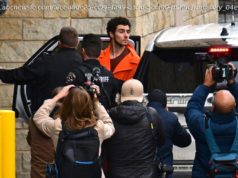Stephon Clark’s death, which took up to 10 minutes, reignited the familiar anger and calls for justice after similar shootings by police of unarmed black men in the United States.
SACRAMENTO, Calif. — Unarmed Stephon Clark was shot eight times, mostly to the back by two Sacramento police officers in his grandmother’s backyard, according to an independent autopsy that was released Friday amid growing tensions in the city and across the nation.
Clark’s death, which took up to 10 minutes, reignited the familiar anger and calls for justice after similar shootings by police of unarmed black men in the United States.
Dr. Bennet Omalu, who conducted the autopsy, said Clark was clearly shot from behind. Six of the bullets hit the back of his body. He said the two others hit him in the side and thigh.
“The truth is a crucial step in getting justice,” Ben Crump, the family’s attorney said at a Friday news conference. “We pray for justice and that the family would get justice.”
Flanked between two large posters showing where bullets entered Clark’s body, Omalu detailed how Clark died.
“The entire interaction, he had his back to the officers,” said Omalu, who is known for his work on the affects concussions have on the brains of athletes.
The first bullet hit him in the side with his back “slightly facing the officers,” Omalu said, which caused his body to turn.
His back was facing officers when a barrage of six bullets hit him.
One hit his neck, the others hit his back and shoulder.
The last gunshot hit his thigh, Omalu said, explaining Clark was either shot while on the ground or as he was falling.
Clark didn’t immediately die from his wounds, he said. His death took up to 10 minutes.
The independent autopsy results were released during a Friday news conference, just one day after Clark’s funeral. His family hired attorney Ben Crump, a high-profile civil rights lawyer who has also represented the families of Trayvon Martin, Tamir Rice and Michael Brown.
Crump said the results directly contradict the narrative from Sacramento police.
“Well, it’s very simple. The narrative that had been put forth is that they had to open fire because he was charging at them. Well, obviously based on Dr. (Bennet) Omalu’s findings in the family’s autopsy, it suggests all the bullets were from behind.”
The official coroner’s report hasn’t been released. Officers, who falsely thought Clark was holding a gun, fired 20 rounds at him, the department said after the shooting.
Clark was found only with a cell phone.
On Friday, Clark’s funeral drew hundreds and spurred protests throughout the city. Since his death on March 18, mostly non-violent protests have stopped traffic, blocked access to two NBA basketball games and disrupted a local city council meeting.
Other Black Lives Matter protests, including one in New York, led to some arrests.
Activist Al Sharpton gave the eulogy for Clark, 22, and derided the White House for dismissing the killing as a “local matter.”
“This is not a local matter,” Sharpton shouted during his remarks. “They have been killing young black men all over the country, and we are here to say that we are going to stand with Stephon Clark and his family.”
Clark’s death is far from the first police interaction turned tragic, as the local chapter of Black Lives Matter lists a dozen violent encounters last year alone.
Some want police to face criminal charges and donned black shirts calling for justice, a common sentiment after similar high-profile cases, such as Michael Brown in Ferguson, Philando Castile in Saint Paul and Eric Garner on Staten Island.
There is hope, however, that Clark’s death could bring the moment for change.
“It could be up to us to affect change, and we can do it because fundamentally we are a highly diverse, integrated community,” said Joany Titherington, president of the Oak Park Neighborhood Association, home to a large part of the city’s African-American population.
“We have black, brown and white people all living next to each other, so what this really is a police training issue, where people shoot first and ask questions later,” she said. “It’s a systemic problem national politicians don’t seem to want to deal with, even though no town in America is immune to this.”
Many point to Sacramento’s new police chief, Daniel Hahn – the first African-American to lead the department.
Lindsay Williams, a member of the local Black Lives Matter movement, thinks systemic changes in how police officers treat minorities will take time.
“There’s an amazing solidarity among our community that cuts across races and agendas,” said Williams. “Now, I’m 27, so based on what I’ve lived through I really don’t expect changes. This country has not given me much to have faith in.”
Williams then looked at the chanting crowd and smiled. “But,” she said, “these people do.”
Contributing: KXTV; Marco della Cava, USA TODAY






